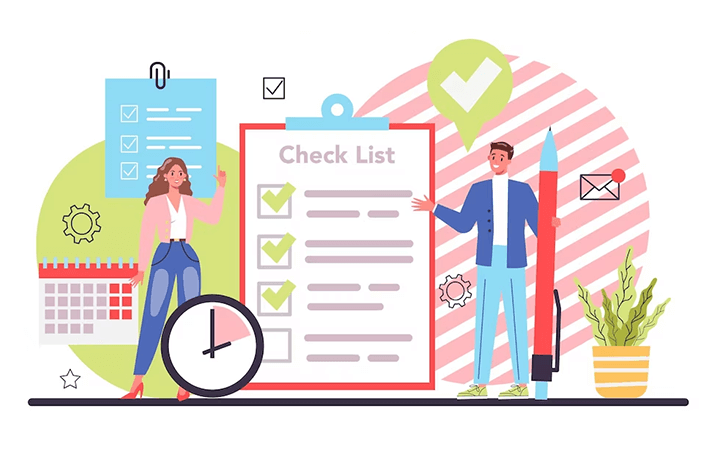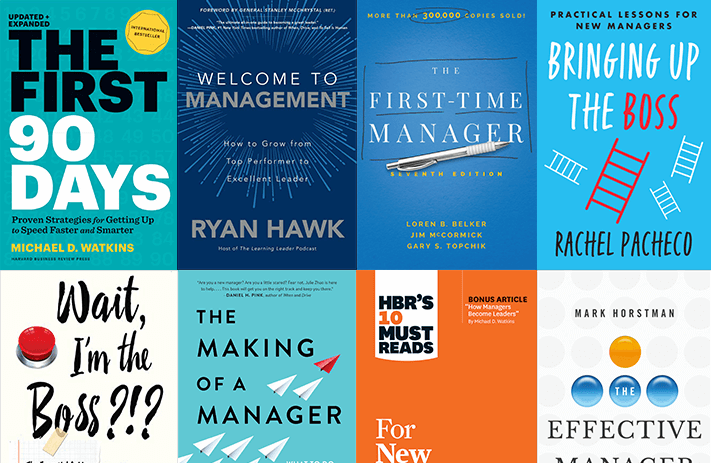
Click the button to start reading
Kick off Your Project with This Project Management Checklist
Ready to take your project management game to the next level? Your ultimate guide is here – a project management checklist to serve as a GPS. It’ll ensure you never miss a beat on your journey to project completion.
In the fast-paced world of today, it’s easy to make mistakes or miss critical details. But with this checklist, you can rest assured that your project will be a success, free from neglect and slip-ups.
Say goodbye to uncertainty and hello to a streamlined, organized approach to project management.
Your practical checklist for project management
- Set the project’s vision
- Define your primary and secondary goals
- Specify the process you’ll use
- Allocate your resources
- Work out the project’s duration and milestones
- Do risk planning
- Agree on how the team will communicate
- Monitor the progress
- Assess the outcomes

What is a project management checklist
A project management checklist is a document that includes all the necessary steps for successful project completion. It’s used to keep track of a project’s progress, goals, resources and deadlines. In addition, it allows you to monitor various elements involved in your project journey.
Obviously, a list in project management is more detailed and contains more information than the one for your grocery shopping. But the goal is the same: to stay organized and keep track of the tasks you have to complete.
Why do you need a quality checklist in project management?
Feeling overwhelmed and frazzled? Fear not! A thorough checklist is your companion in the most hectic times. It allows you to stay cool-headed and see the bigger picture. A single look at the checklist may prompt you where your priorities lie and how each task contributes to the project’s completion.
Project management checklists are helpful in a number of ways:
- Project priorities are clear.
It’s easy to lose track of important tasks when something urgent comes at you every other moment. Successful project managers use checklists to easily identify which task matters. Then, advise their teams on what to complete in the first place. - You manage your resources effectively.
Time, money, labor, materials… A quality checklist will ensure you’ve considered all aspects of resource management. By using a structured approach, you can allocate your resources efficiently and plan expenses in advance. - It’s easy to juggle multiple responsibilities.
Wearing too many hats to move your project forward? You’re hardly alone. Keep your organized list at hand, and you’ll be able to simultaneously oversee all your teams, deliverables, and tasks. - You confidently prevent issues and mitigate risks.
No project comes to its completion without unexpected twists or disruptions. With a detailed checklist, you can think ahead and identify potential risks before they hit. It allows you to anticipate constraints and run projects more confidently.

How to create a project management checklist?
Only rookies start from a blank page. Experienced project managers, on the other hand, know well that developing any checklist should start with preparation.
Let’s single out three main steps you shouldn’t miss in the preparation stage:
Step 1: Research your project.
Especially if you’re new to the industry, familiarize yourself with past reports and industry standards. Explore the accomplishments within your company and know what the trends are. Learning the strengths and weaknesses of your team wouldn’t go amiss, too.
Step 2: Know your stakeholders.
Each project has its stakeholder, be they the investors, clients, contractors or company leadership. Therefore, get to know everyone who’s involved in the project development or is affected by its outcomes. Take note of their priorities and expectations. This will help you to effectively map out your project plan and deliverables.
Step 3: Document project requirements.
Each element of your project may have specific requirements you can’t disregard. Find out those requirements and success metrics before you create your checklist. Actively communicate with those who can help you document the nitty-gritty details – with a potential impact on your project.

Developing a checklist for your project management plan
Now that you’ve done your preparation, grab these nine items to develop an effective checklist.
1. Set the project’s vision.
If something ended successfully, it started with a vision. Why? Because the vision connects your project deliverables with the mission of your organization. In other words, it helps you understand how your project fits into larger corporate objectives.
Also called a project charter, a vision statement brings all elements together and sets the lighthouse for the entire project. That’s why, while setting the vision, it’s a good idea to take into account the company’s plans and your team’s ambitions.
Sometimes only a few sentences long, a good vision statement not only serves as a guiding light. It can also help you make a case for your next project, especially if you’re just starting as a project manager.
2. Define your primary and secondary goals.
Every vision needs a roadmap to be accomplished. Goals are the link to tie your project to the vision. Goals should be ambitious, but most importantly, they should be achievable.
While classifying your goals as primary or secondary, you’ll need to consult the documents you created in the preparation stage. Be mindful and consider the expectations of all parties involved and the resources available.
Many factors will impact your decisions and what matters most for a particular project. Suppose you’re starting a new business with limited money and a set launch date. In this case, your top priorities are likely to be – keeping costs low and hitting your deadline. Everything else might have to take a backseat for now.
For healthcare spaces, making sure conversations are private and everything is easy to clean are especially important. And if you have a product launch in just two months, finishing delivering the project on time becomes your biggest priority.
Thus, your primary objectives will dictate your project plan and the breakdown of tasks for each milestone.
3. Specify the process you’ll use.
Sometimes our job descriptions have nothing about project management, but we’re assigned to complete a project. Challenging, huh? If that’s your case, explore the different frameworks in project management (such as the waterfall, agile, scrum, lean and other methodologies). Pick the technique that’ll work best for your particular case.
If you’re a seasoned project manager, you can go creative with the use of existing tools and frameworks. Mix and match to avoid a forced flow and select the optimal execution plan for your specific project.
4. Allocate your resources.
Equipment, production materials, software, schedules – everything should be put on your project plan. And if you need to figure out how to divvy up your resources, here are some examples of resource allocation at the company level:
- Labor: This includes the people you need to get the job done, whether they’re full-time employees or contractors with different areas of expertise.
- Tools/Equipment: Depending on your organization, this could cover everything from software to hardware.
- Facilities: You’ll need a place to work, whether that’s a big conference room or a whole office building. If you’re 100% remote, then a project management tool should be on your list.
- Materials: Whatever you need to produce your final product, from office supplies to raw materials for construction.
- Budget: Of course, all of the above require money, so you’ll need to budget accordingly.
A complete map of your resources will help to cut things for one project and add stuff to the pool for another one.

5. Work out the project’s duration and milestones.
What can be done, and when can it be completed? Resource scheduling is all about answering these questions.
Sometimes, no matter how smart or well-prepared you are, it’s impossible to cram so much into so little time. And don’t even think, “Well, if I can make them work a bit harder…”. Remember, the number of tasks your team can complete is a finite number, and you should have an appreciation for your team’s capacity.
According to the Pulse of the Profession report, only 51% of projects in an organization finish within the initially scheduled times. Avoid becoming a part of these statistics by planning for potential schedule updates. When setting your milestones, allocate time for unexpected delays and roadblocks.
The next point on our checklist of project management is about being prepared for the unforeseen.
6. Do risk planning.
Risks are like a hurricane. They usually hit without warning and leave you in the middle of something really frightening.
Your project management checklist must involve a plan on how to survive such risks. So, get prepared before the storm hits.
Look into your answers to these three important questions:
- What’s the expected quality of the final outcome?
- What’s the timeline?
- What resources do I have?
Balance all three elements and have a response plan in place. Most importantly, add a little bit of flexibility in your deliverables, timeline, and resources. Ask questions like “What can go wrong?” and “What if…?” and log all risks into a risk register. Don’t forget to set responsibilities for following the risk management plan. Everyone should know their roles when it’s time to address unplanned issues.
Remember that risk management should be integral to any change request, as changes always impose risks.
7. Agree on how the team will communicate.
PMI says poor communication is one of the major reasons for project failure.
All your team members and stakeholders should know how you’re going to communicate throughout the project. You need to have clear communication routes to talk about updates, accomplishments, alterations, and missing elements.
Projects come in all shapes and forms, but most project communication plans contain some or all of these elements:
- Regular emails and messages with project updates;
- Regular check-ins with people working on the project;
- Daily/Weekly check-ins with those assigned high-priority tasks;
- Biweekly meetings with your entire team (and/or team leaders);
- A kickoff meeting to onboard someone new during the project completion.

8. Monitor the progress.
As a project manager, you don’t assign tasks and lean back, waiting for the results to come around. In practice, monitoring will take most of your time and effort.
You need to know what’s on track, what’s behind, and what needs your urgent attention to be accomplished. You’re the one with the high-level overview of the project, so you’re in charge of centralizing and balancing everyone’s efforts. Who is working on what, and how many tasks are left to be completed? Answers to these questions are important to deliver the project on time and within budget.
Effective project monitoring involves making necessary modifications along the way. Since projects usually involve multiple tasks that stretch over a long period, monitoring ensures that each task is completed correctly. Also, it helps to resolve any doubts or obstacles in a timely manner.
9. Assess the outcomes.
If you don’t assess, you don’t learn.
Post-project assessment is a critical process that helps to evaluate your project’s success and identify areas for improvement. By the way, it’s important to decide on the acceptance criteria or key performance metrics (KPIs) so that you’ll be able to assess the end results. Define when the project should be marked as done, and use the data you have collected to evaluate your project.
Make sure to use surveys and interviews to analyze your team’s experiences, client satisfaction, and the efficiency of your processes. Do it individually or as a team. Considering additional perspectives and insights allows you to get it from two angles and be confident you’ve spotted the inefficient processes.
The post-project assessment should identify opportunities for continuous improvement. This involves developing a plan for implementing changes that can improve future projects and prevent similar issues from reoccurring.
Key takeaways
We live in a world that continues to be turbulent. The stakes are high, and the obstacles are ever-present.
The level of competition we face today forces us to be highly competent. Remember, as project managers, you’re the driving force behind success, bringing together diverse talents, managing resources, and achieving outcomes that matter.
To navigate this fast-paced landscape, you need to be equipped with the right tools, skills, and strategies. And that’s where your project management checklist comes in. This invaluable resource will keep you on track, ensuring that all team members are aligned and work together in a consistent and standardized way.
















